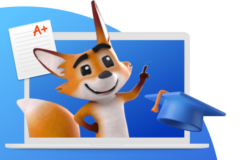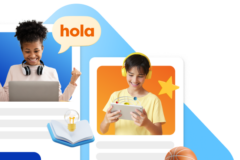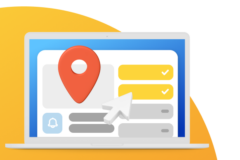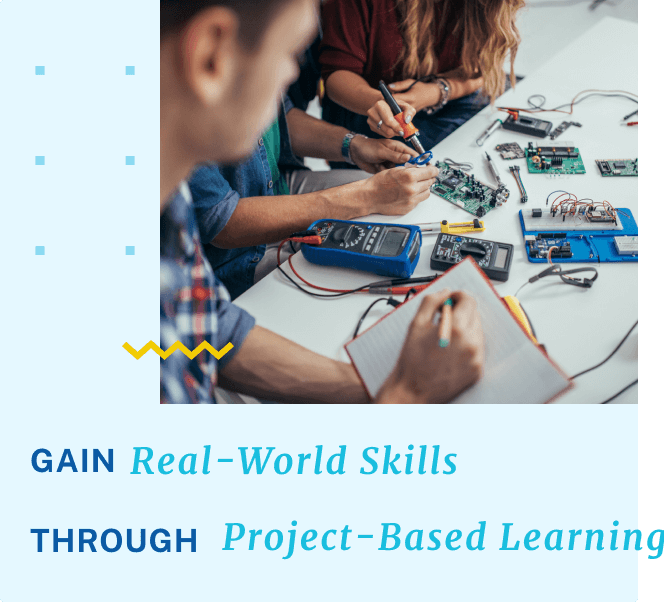Programming Pathway
Dreams of designing software?
Does your student dream of designing their own software? Are they a creative, “can-do” kind of person who loves solving puzzles and challenges with technology? Then, a career as a computer programmer or software developer might be a great fit!
What Programmers Do
Programmers and software developers work for big tech companies; tech start-ups developing new products and services; and companies that develop software for clients in government, healthcare, and other industries.
These jobs are similar in that they both create applications and software to solve business problems for employers, customers, or clients. However, programmers focus almost exclusively on coding in languages such as Python, C++, and Java, while software developers focus on the entire process, from determining business and functional requirements to overseeing programmers to coordinating testing and launch.

Gain real-world skills through project-based learning.
Stride Career Prep integrates project-based learning into the curriculum, so classwork mirrors what students will be doing in the workplace. With project-based learning, there’s little to memorize and repeat. Instead, students are given a real-life problem to solve and must work with a team to come up with a creative solution.
For example, students will be asked to create a gamified solution to remove trash from the ocean using a remotely controlled robot named FRED (Floating Robot Eliminates Debris). They’ll not only tackle a serious real problem—the threat plastic poses to the health of our oceans—but also learn Java, graphics, animation, prototyping, and data structures as well as soft skills such as communication, creativity, teamwork, and critical thinking. And they’ll get feedback on projects from successful professionals in the field.
Our Programming Pathway Curriculum in Detail
All students take the core courses required for high school graduation in their state. The chart below shows the additional classes students take as part of the Programming Pathway. You can see the rest of the curriculum by viewing the full course list.
CAREER EXPLORATION COURSES
These courses provide an opportunity for students to gain insight into potential careers.
CAREER FOUNDATION COURSES
These courses are building blocks that prepare students for more specialized pathway courses.
CAREER PREPARATION COURSES
These courses prepare students for industry-recognized certification exams.
OPTIONAL CAREER LEARNING COURSES
While not required, these courses provide an opportunity for students to gain knowledge and skills that are useful in their chosen careers.
IT Explorations
Computer Science Principles
OR
Computer and Cloud Fundamentals††
Python Programming A & B
OR
Introduction to Java Programming 1
Introduction to Java Programming 2
OR
Data Structures in C++ 1*†
Data Structures in C++ 2*†
*Intro to JavaScript is a pre-requisite
Green Design and Technology
Computer Science I A & B
Virtual Reality
Mobile Apps
AP® Computer Science Principles A & B
Note: Pathway courses are subject to change.
†New in fall 2022
††New in spring 2023
Get credentialed.
In a world where competition for jobs, pay increases, and academic success continues to increase, certifications provide a credible, third-party assessment of a student’s skills and knowledge of a given subject. Students in this pathway can prepare to take these industry-recognized certification exams:**
CAREER SKILLS CERTIFICATIONS
These baseline certifications prepare students with domain-specific, entry-level job skills.
IC3 G5 Living Online
CompTIA ITF+
CompTIA Cloud Essentials
NOCTI Computer Programmer
NOCTI Visual Communications and Interactive Media
EMPLOYMENT READY CERTIFICATIONS
These certifications indicate students have acquired skills needed to perform a job with little or no support.
EMPLOYMENT READY CERTIFICATIONS
These certifications indicate students have acquired skills needed to perform a job with little or no support.
AWS Cloud Practitioner
Find a school near you that offers the Programming Pathway.
Stride Career Prep programs with the Programming Pathway are available at tuition-free K12-powered public online schools in the following states:
MINNESOTA
Minnesota Virtual Academy
SOUTH CAROLINA
Cyber Academy of South Carolina
ARKANSAS
Arkansas Virtual Academy
MISSOURI
Missouri Virtual Academy
WYOMING
Wyoming Virtual Academy
LOUISIANA
Louisiana Virtual Charter Academy
Don’t see your state? Check out the tuition-based option here in the Programming Pathway. There are also tuition-free options in related fields like game design!
Choose a career. Prepare for the future.
Computer programmers write and test code in languages such as C++, Java, and Python that allow computer applications and software programs to function properly. They turn the program designs created by software developers and engineers into instructions that a computer can follow. In addition, programmers test newly created applications and programs to ensure that they produce the expected results. There can be overlap with the duties of software developers.
2021 Median Salary
$93,000
Expected Job Growth Rate for 2020–2030
Declining
Typical Entry-Level Education
Bachelor’s degree preferred; some employers may accept commensurate experience, demonstrated through a portfolio of programming content including apps, and/or give job candidates a coding challenge to complete.
This data reflects the information available from the Bureau of Labor Statistics, U.S. Department of Labor, Occupational Outlook Handbook on June 29, 2022. To learn more about this occupation, visit bls.gov/ooh/computer-and-information-technology/computer-programmers.htm.
Software developers manage all aspects of developing a software program. They interface with customers to understand the goal of the software project and all required functionalities. They also identify requirements related to security, capacity, and speed. They document all requirements and workflows and serve as the liaison between the customer and the computer programmers who code the software. They are ultimately responsible for ensuring the software meets the customers’ needs.
2021 Median Salary
$110,140
Expected Job Growth Rate for 2020–2030
Much faster than average
Typical Entry-Level Education
Bachelor’s degree preferred; some employers may accept commensurate experience, demonstrated through a portfolio of programming content including apps, and/or give job candidates a coding challenge to complete
This data reflects the information available from the Bureau of Labor Statistics, U.S. Department of Labor, Occupational Outlook Handbook on June 29, 2022. To learn more about this occupation, visit bls.gov/ooh/computer-and-information-technology/software-developers.htm.
Computer and information systems managers, also called information technology (IT) managers or IT project managers, plan, coordinate, and direct IT activities in an organization. They help determine the information technology goals of an organization and then develop and implement a plan to achieve these goals. This includes procuring, developing, installing, and maintaining required hardware and software and overseeing a team of IT professionals, which may include computer systems analysts, software developers, information security analysts, and computer support specialists. Computer and information systems managers may have more specific titles such as chief information officers, chief technology officers, IT directors, and IT security managers.
2021 Median Salary
$159,010
Expected Job Growth Rate for 2020–2030
Faster than average
Typical Entry-Level Education
Bachelor’s degree
This data reflects the information available from the Bureau of Labor Statistics, U.S. Department of Labor, Occupational Outlook Handbook on June 29, 2022. To learn more about this occupation, visit bls.gov/ooh/management/computer-and-information-systems-managers.htm
FAQs
You do not necessarily need a college degree to get a job as a coder/programmer or software developer. Most programmers have a bachelor’s degree in computer science, but in many companies, the only requirement is demonstrated advanced skills in object-oriented programming languages including Java, C++, and Python. Employers often give candidates a coding challenge, sometimes called a technical interview, to assess each candidate’s aptitude for a job. Our Programming Pathway is a great way to learn these skills and start developing a portfolio while completing high school.
Java, C++, and Python are the most useful programming languages to learn right now. Our Programming Pathway includes coursework in each, and we also help prepare students to take the relevant certification exams. Other in-demand languages right now include Pearl, Scarla, and Go.
Apple, Google, and IBM are among tech companies willing to consider candidates without a college degree. That doesn’t mean that it’s easy to get a job there, though! You’ll need to have excellent programming and problem-solving skills, be a whiz at several programming languages, and write a killer cover letter highlighting tangible accomplishments (e.g., apps or programs you’ve developed that have solved an organizational need) and your ability to effectively collaborate with other members of a programming team. If you get an interview, you’ll need to demonstrate those skills—and keep your cool under pressure—by completing a coding challenge developed by the employer. Hackathons and coding competitions, like those organized by Business Professionals of America (BPA), are great ways to simulate this experience, build a portfolio, and get a leg up on the competition. That’s why our Programming Pathway features a project-based curriculum that allows students to build a portfolio while learning Java, C++, and Python. Membership to BPA is also included in our tuition-free program.*** BPA sponsors coding competitions, provides networking opportunities, and offers scholarships!
While in high school, you can learn as many coding languages as possible, develop a portfolio of work, and, ideally, intern or job shadow at a software company. Participate in hackathons, join student IT clubs, and develop apps and games. Classes in computer science, computer programming logic, and specific languages are helpful. And be sure to check out these additional articles about Galvanize!
*Stride Career Prep is a program for grades 9–12. Some schools offer career exploration in middle school.
**Many Microsoft®️ Office certificates can be earned after completing one course. Other certificates require more classes to be better prepared, and students who participate in the program for at least two years will have further preparation for certification testing.
***Opportunities vary by school; please visit your school page or check with your school counselor.














